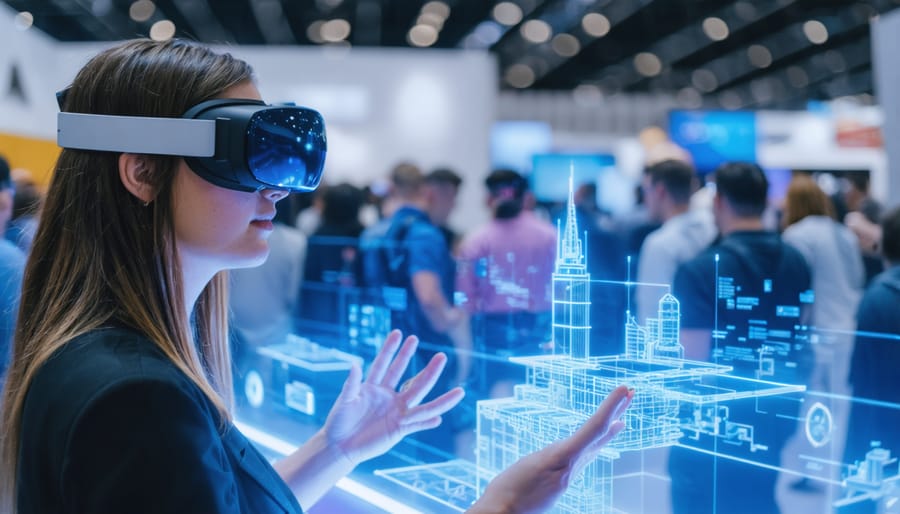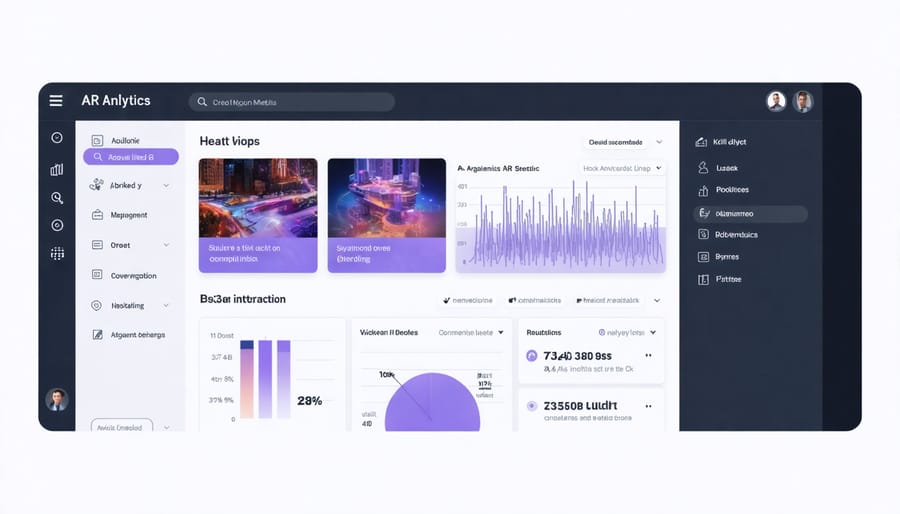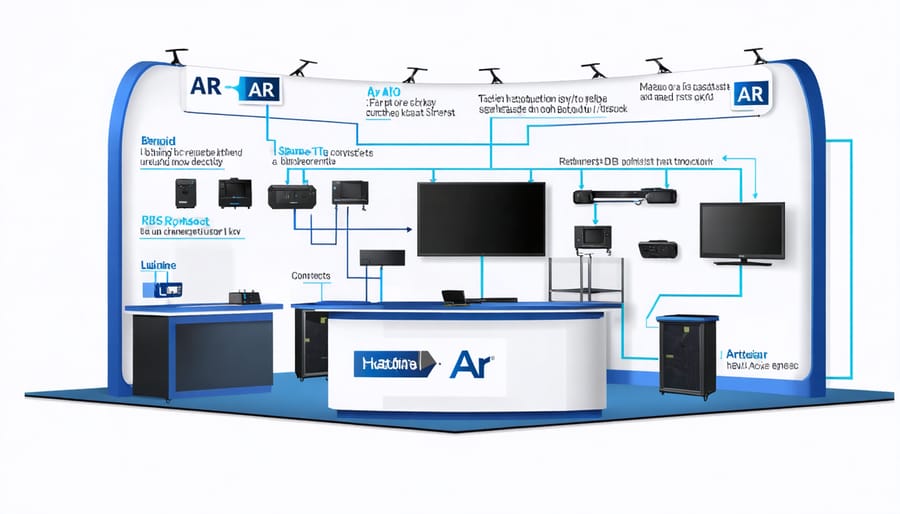AR Trade Shows Transform B2B Sales (Real Results Inside)

Transform your trade show presence with augmented reality to deliver personalized B2B experiences that capture attention and drive engagement. AR technology now enables exhibitors to showcase complex products through interactive 3D demonstrations, reduce physical inventory costs, and collect valuable analytics on visitor interactions. Forward-thinking businesses leverage AR to create immersive product configurations, virtual facility tours, and real-time data visualization experiences that traditionally required extensive physical space or equipment. By implementing AR solutions, exhibitors report up to 70% higher booth engagement rates and a 35% increase in qualified lead generation compared to traditional display methods. The technology’s ability to blend digital content with physical spaces creates memorable brand experiences while providing measurable ROI through detailed user interaction data and immediate feedback collection. This revolution in trade show marketing enables businesses to stand out in crowded exhibition halls while simultaneously reducing logistical overhead and maximizing booth space efficiency.
How AR Elevates Your Trade Show Presence
Interactive Product Demonstrations
Interactive product demonstrations powered by augmented reality are revolutionizing the trade show experience by allowing exhibitors to showcase their products in ways previously impossible. Instead of bringing large, heavy equipment or multiple product variations to the show floor, businesses can now present their entire product line through immersive AR experiences.
Attendees can interact with virtual product models using tablets, smartphones, or AR headsets, allowing them to explore features, dimensions, and functionality in real-time. For example, a manufacturing company can demonstrate how their machinery works through animated 3D models, complete with moving parts and operational sequences, all without the logistics and safety concerns of running actual equipment.
These AR demonstrations enable customers to visualize products in their intended environment. Architecture firms can show how buildings will look in specific locations, while furniture manufacturers can help buyers see how pieces would fit in their spaces. The technology also allows for real-time customization, where attendees can change colors, sizes, or configurations instantly.
Product demonstrations become more engaging through interactive features such as:
– Exploded view animations showing internal components
– Virtual control panels for testing functionality
– Real-time product configuration options
– Performance simulation scenarios
– Side-by-side comparison capabilities
For complex products, AR demonstrations can include step-by-step assembly instructions or maintenance procedures, providing valuable training opportunities right on the show floor. Sales teams can capture attendee interactions with the AR demonstrations, gathering valuable data about which features attract the most interest and how potential customers engage with the products.
By combining physical and digital elements, these interactive demonstrations create memorable experiences that help businesses stand out at trade shows while providing practical value to potential customers.

Data-Driven Engagement Tracking
AR technology at trade shows goes beyond creating impressive displays – it’s a powerful tool for gathering actionable data about visitor engagement and behavior. By implementing predictive analytics for visitor tracking, businesses can measure and analyze multiple engagement metrics in real-time.
Key metrics tracked through AR interactions include dwell time at specific displays, most popular features accessed, and user interaction patterns. This data helps exhibitors understand which products or services generate the most interest and how visitors engage with different AR experiences.
Heat mapping capabilities show traffic flow patterns and popular congregation points, allowing businesses to optimize booth layout and staff positioning. The technology can also track gesture interactions, providing insights into how intuitively visitors understand and use AR interfaces.
Demographics data collection through AR applications helps build detailed visitor profiles, including industry sectors, job roles, and specific interests. This information proves invaluable for post-show follow-up and future marketing strategies.
Real-time analytics dashboards enable immediate adjustments to AR experiences based on visitor response. If certain features aren’t performing well, exhibitors can modify content or presentation methods on the spot to improve engagement.
The system can also track lead qualification metrics by monitoring factors such as time spent with specific products, information downloaded, and direct inquiries made through AR interfaces. This helps sales teams prioritize follow-up activities and customize their approach based on demonstrated interests.
By combining these insights with traditional trade show metrics, businesses can calculate precise ROI and make data-driven decisions for future events. The gathered data serves as a foundation for continuous improvement in both AR implementations and overall trade show strategy.

Implementing AR at Your Next Trade Show
Technical Requirements and Setup
To successfully implement augmented reality at your trade show booth, you’ll need several key components working together seamlessly. First, ensure you have reliable high-speed internet connectivity with a minimum of 50 Mbps download and 20 Mbps upload speeds. Consider having a backup connection or mobile hotspot for redundancy.
For hardware, you’ll need AR-capable devices such as tablets or smartphones with good cameras and processing power. Popular choices include recent iPad Pro models or high-end Android tablets. If you’re planning headset-based experiences, consider devices like Microsoft HoloLens 2 or Magic Leap 2. Plan for at least 2-3 devices per demonstration station to handle multiple visitors.
On the software side, choose an AR development platform that matches your needs. User-friendly options include Vuforia, ARKit, or ARCore for app development. For simpler implementations, web-based AR platforms like 8th Wall or Zappar offer quick deployment without requiring app downloads.
Essential infrastructure includes:
– Stable power supply with backup options
– Device charging stations
– Secure mounting systems for tablets
– Anti-theft tethers for expensive equipment
– Adequate lighting for optimal AR tracking
– Non-reflective surfaces in the demonstration area
Consider having technical support staff on-site during the show to quickly address any issues. Create a troubleshooting guide and train your booth staff on basic technical problem-solving to ensure smooth operation throughout the event.

Staff Training and Preparation
Effective staff training is crucial for maximizing the impact of AR demonstrations at trade shows. Begin by ensuring all booth personnel understand the basic principles of AR technology and can explain its benefits in clear, business-focused terms. Training should focus on both technical proficiency and customer engagement skills, as staff need to balance AI-enhanced customer interactions with personal touch.
Create a comprehensive training schedule at least three weeks before the event. Include hands-on practice sessions with AR devices, troubleshooting scenarios, and role-playing exercises. Staff should be able to:
– Launch and restart AR applications smoothly
– Guide visitors through the AR experience step-by-step
– Address common technical issues quickly
– Articulate your product’s value proposition through AR demonstrations
– Manage multiple visitors simultaneously
Develop clear protocols for device handling, sanitization, and maintenance. Assign specific roles to team members, including technical support leads and demonstration specialists. Create quick-reference guides for common issues and keep them readily accessible during the event.
Consider implementing a buddy system where experienced staff members mentor newer team members. This ensures consistent delivery of demonstrations and helps maintain high energy levels throughout long show days. Regular team briefings during the event will help address any challenges and share successful engagement strategies.
Measuring ROI from AR Trade Show Investments
Measuring the return on investment (ROI) from AR trade show implementations requires a systematic approach that combines traditional metrics with digital analytics. Start by establishing baseline metrics from previous trade shows, including lead generation numbers, conversion rates, and average deal sizes, to enable meaningful comparisons.
Key performance indicators (KPIs) for AR implementations should track both quantitative and qualitative metrics:
1. Engagement Metrics:
– Number of AR interactions
– Average interaction duration
– User progression through AR experiences
– Social media shares and mentions
– IoT-driven engagement metrics
2. Lead Generation Metrics:
– Number of qualified leads
– Lead quality score
– Contact information captured
– Follow-up meeting requests
3. Financial Metrics:
– Cost per lead
– Conversion rate to sales
– Revenue generated from AR-engaged leads
– Total implementation costs
Calculate your ROI using this formula:
(Revenue Generated – Total AR Investment) / Total AR Investment × 100
To ensure accurate attribution, implement unique tracking codes for AR-generated leads and maintain detailed analytics throughout the sales cycle. Consider both immediate returns (leads generated during the show) and long-term value (brand awareness and market positioning).
Factor in these additional considerations:
– Reduced printing and shipping costs for physical materials
– Staff training and support costs
– Hardware and software investments
– Content creation and updates
Create a comprehensive ROI report that includes:
– Comparative analysis with traditional methods
– Customer feedback and satisfaction scores
– Brand visibility metrics
– Future scaling opportunities
Remember that first-time AR implementations may show lower initial returns due to setup costs, but efficiency typically improves in subsequent shows as teams become more experienced and content can be reused.
As we’ve explored, augmented reality is transforming the trade show landscape, offering unprecedented opportunities for engagement and lead generation. To get started with AR at your next trade show, begin by identifying clear objectives and selecting appropriate AR applications that align with your business goals. Consider partnering with experienced AR developers and creating a pilot program to test different features before full implementation. Remember to train your staff thoroughly and develop metrics to measure success. The investment in AR technology, while significant, can deliver substantial returns through increased booth traffic, enhanced customer engagement, and improved data collection. Take the first step by assessing your current trade show strategy and identifying areas where AR could provide the most impact. With proper planning and execution, AR can become a powerful tool in your trade show arsenal, helping you stand out in an increasingly competitive exhibition environment.
Leave a Reply